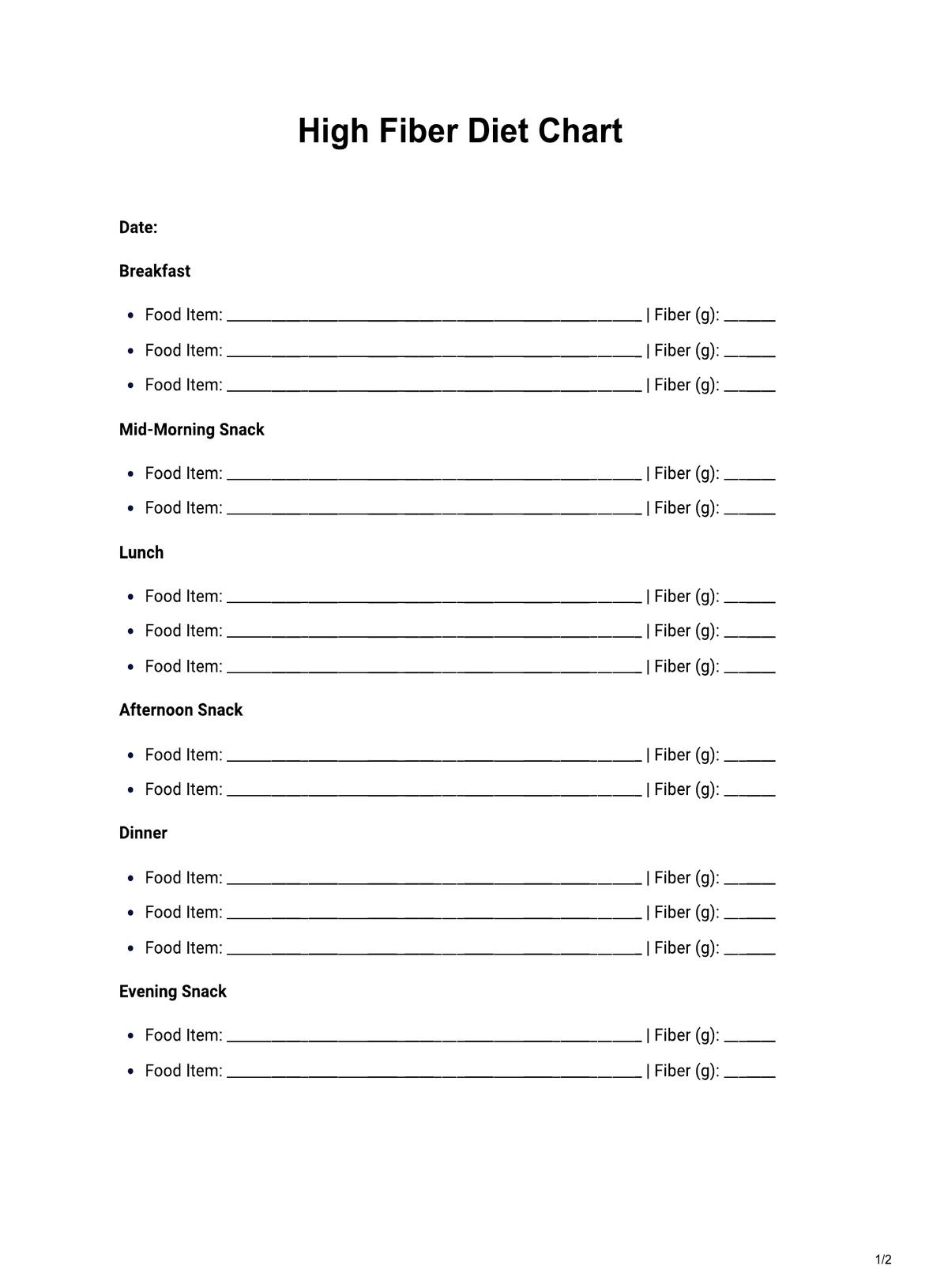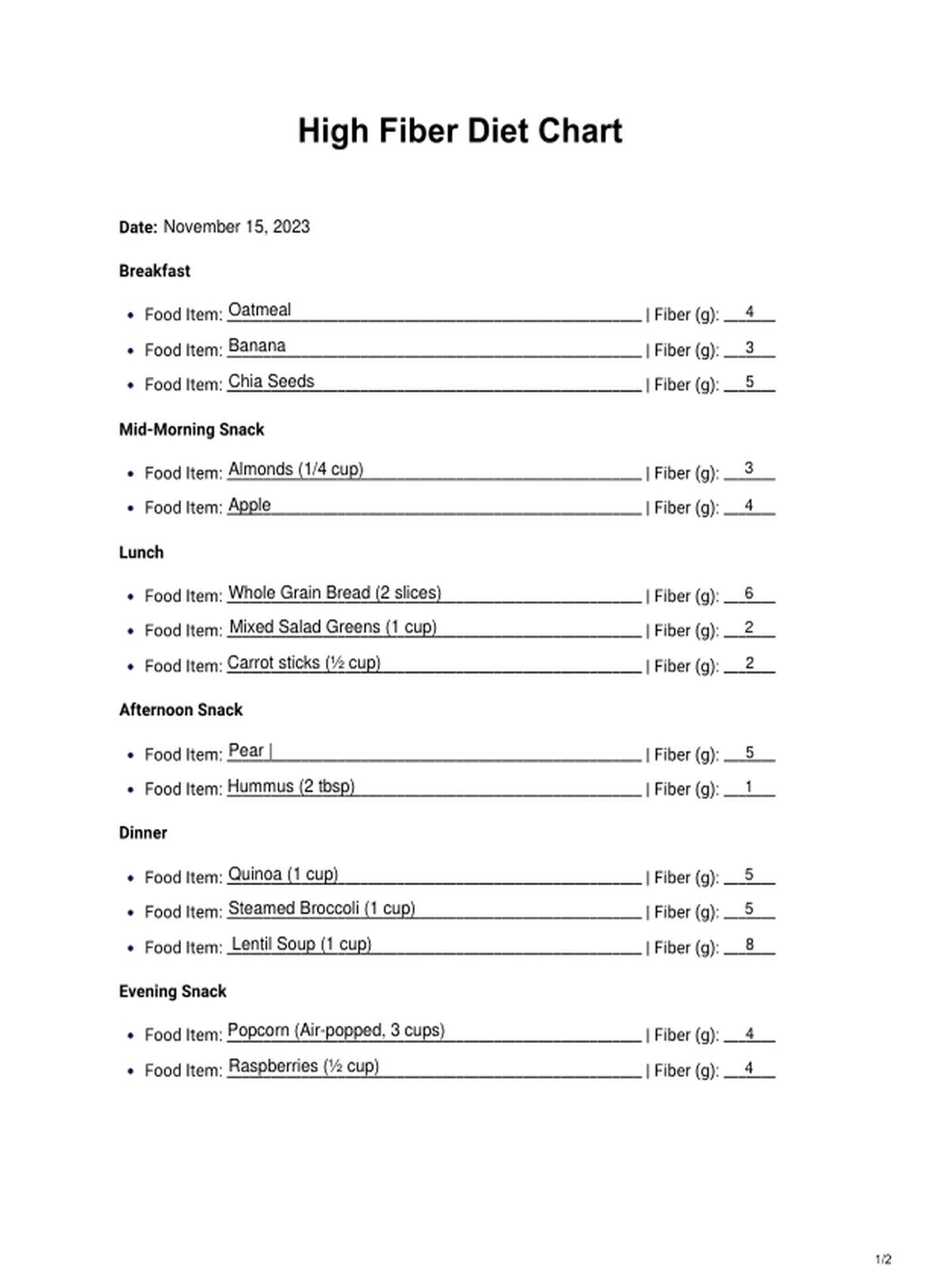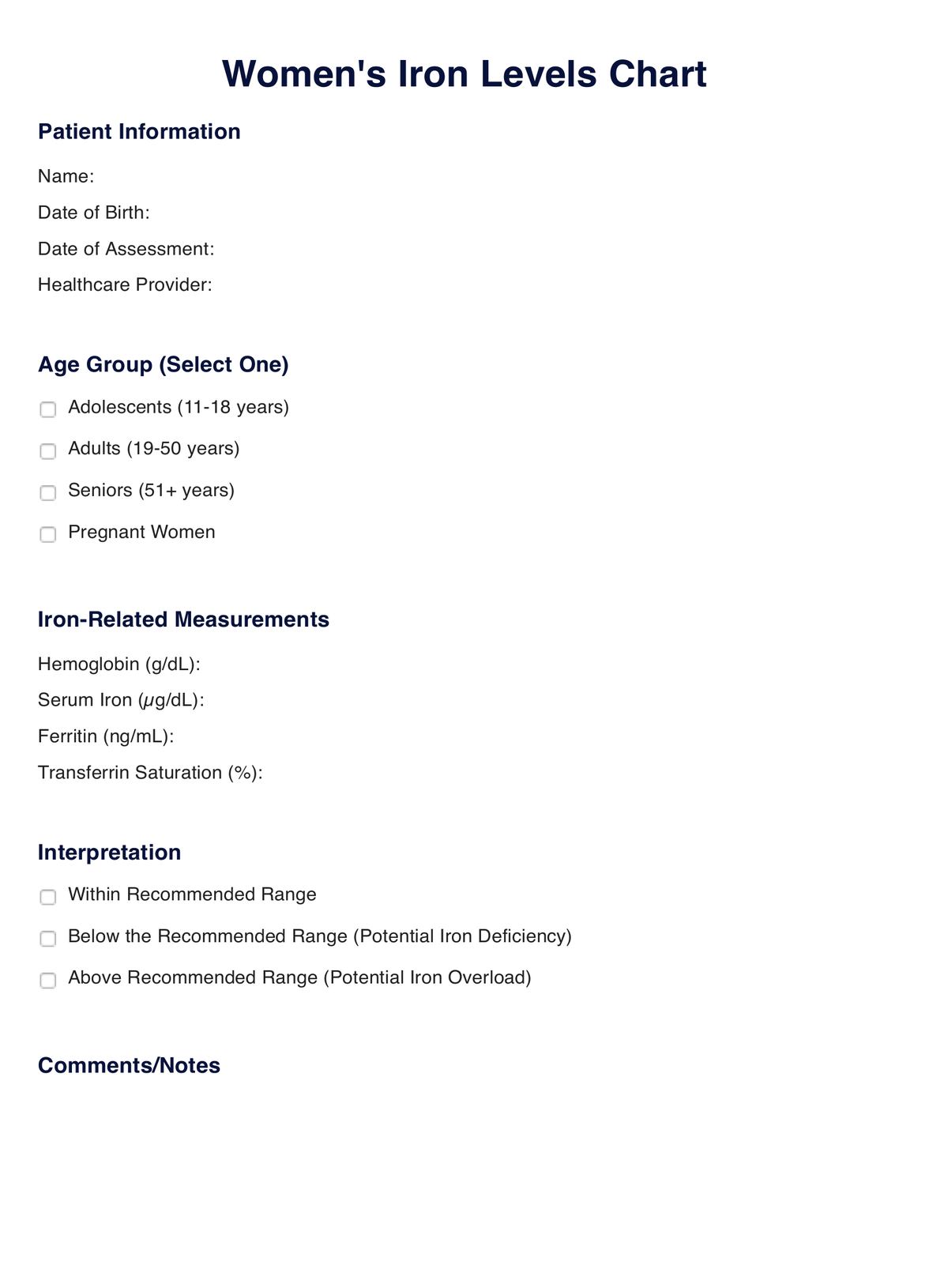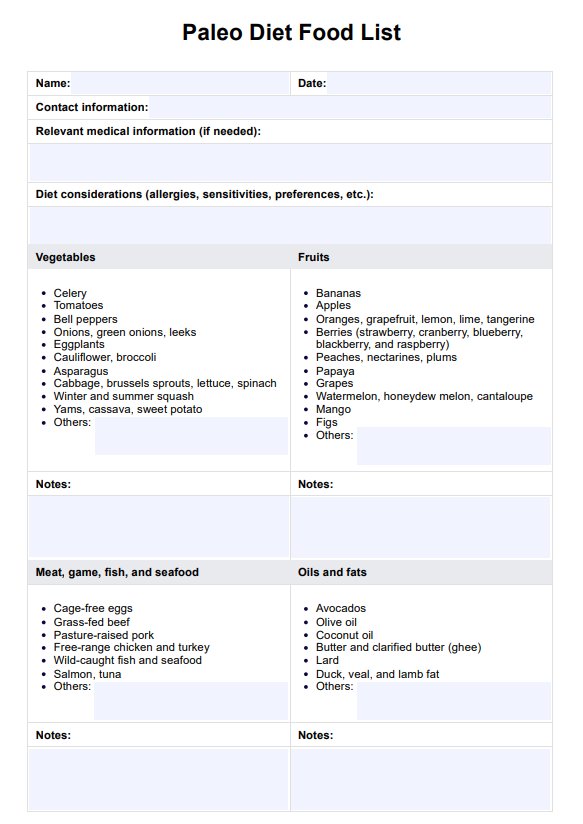High Fiber Diet
Explore our High Fiber Diet Chart with a detailed example, perfect for daily tracking. Download your free PDF guide now and start your journey to better health.


What is a High Fiber Diet Chart?
A High Fiber Diet Chart is an invaluable resource for anyone looking to improve their dietary habits and overall health. Essentially, it's a structured plan that helps individuals track and increase their intake of dietary fiber, an essential component for optimal digestion and numerous other health benefits. The chart is designed to guide users through their daily meals, categorizing foods based on their fiber content and providing a clear framework for what to eat at each meal and snack throughout the day.
This tool is particularly beneficial for those new to high-fiber diets or anyone seeking to manage their dietary fiber intake methodically. Using the chart, individuals can easily monitor the amount of fiber they consume, ensuring they meet the recommended daily intake without guesswork. This can be especially helpful for people with specific health goals, such as improving digestive health, managing blood sugar levels, or aiding in weight management.
The High Fiber Diet Chart is more than just a tracker; it's an educational tool that empowers users to make informed food choices. By understanding which foods are high in fiber and how they can be incorporated into daily meals, individuals can develop healthier eating habits that have long-term benefits for their overall well-being. In the following sections, we will delve deeper into the specifics of the High Fiber Diet Chart, providing insights and practical tips on utilizing this resource effectively.
High Fiber Diet Template
High Fiber Diet Example
How Does It Work?
Utilizing a Printable High Fiber Diet Chart is straightforward. It can be seamlessly integrated into daily routines, whether for personal health tracking or within a professional setting, such as practice management software for dietitians and nutritionists. Here are the steps involved in using and filling out the form:
Step 1: Access and Print the Chart
The first step is to access the Printable High Fiber Diet Chart. It's typically available as a PDF download, making printing easy. This chart can often be integrated into the software for health professionals using practice management software, allowing for easy access and use with clients.
Step 2: Understand Fiber Requirements
Before you start filling out the chart, it’s essential to understand the daily fiber requirements. This knowledge will guide you in choosing the right foods and portions to meet your dietary needs.
Step 3: Plan Your Meals
Using the chart, plan your meals for the day. This includes breakfast, lunch, dinner, and any snacks. List each food item you intend to eat and its corresponding fiber content. This step encourages mindful eating and helps diversify your diet with high-fiber foods.
Step 4: Record Your Intake
As you consume your meals and snacks throughout the day, record them on the chart. Write down each food item and the amount of fiber it contains. This step is crucial for tracking your fiber intake compared to your planned intake.
Step 5: Calculate Total Daily Fiber
Calculate the total amount of fiber you consume. This will give you a clear picture of how close you are to meeting your daily fiber goals.
Step 6: Review and Adjust
Review your intake and assess if you are meeting your fiber requirements. If not, adjust your meal plans to include more high-fiber foods for the following days. This step is essential for continuous improvement and achieving your dietary goals.
Step 7: Repeat and Monitor Progress
Repeat this process daily. Over time, you’ll be able to monitor your progress and make informed decisions about your diet. For those using practice management software, this data can be valuable for tracking client progress and making dietary recommendations.
The High Fiber Diet Chart is more than just a tool for tracking; it's a guide to healthier eating habits. By consistently using this chart, you can significantly improve your dietary fiber intake, leading to better digestive health and overall wellness.
When Would You Use This Chart?
The High Fiber Diet Chart is a highly adaptable tool suitable for various contexts, ranging from individual health improvement efforts to professional healthcare practice. For individuals aiming to enhance their digestive health, manage weight, or maintain healthy blood sugar levels, this chart is an invaluable resource for tracking and increasing fiber intake. It's particularly beneficial for those transitioning to a high-fiber diet, offering a structured approach to gradually incorporating more fiber-rich foods.
Healthcare professionals can integrate this chart into their practice, including dietitians, nutritionists, general practitioners, health coaches, and fitness trainers. It serves as a helpful aid in dietary planning and counseling, helping clients and patients understand and improve their fiber intake. In cases where patients have specific health conditions like irritable bowel syndrome, diabetes, or high cholesterol, this chart becomes an essential part of dietary management.
Moreover, the High Fiber Diet Chart finds its use in educational settings. It can be a significant tool in nutritional education workshops or classes focusing on healthy eating. Schools and universities can also employ it to teach students about the importance of dietary fiber and practical ways to include it in daily meals.
In summary, the High Fiber Diet Chart is more than just a tracking tool; it's an educational resource that assists individuals and professionals in making informed, health-conscious dietary decisions. Its versatility makes it relevant for anyone looking to effectively improve dietary habits and manage health conditions.
What Do the Results Mean?
Understanding the results of a Free High Fiber Diet Chart can provide valuable insights into one's dietary habits and overall health. When you consistently track your fiber intake with this chart, several common results and their implications become apparent.
Meeting or Exceeding Fiber Goals
If the results show that you are consistently meeting or exceeding the recommended daily fiber intake (which is about 25 grams for women and 38 grams for men), it indicates a well-balanced diet rich in fruits, vegetables, whole grains, and legumes. This level of fiber intake is associated with numerous health benefits, including improved digestion, reduced risk of heart disease, and better regulation of blood sugar levels.
Not Reaching Fiber Goals
If the results frequently show a fiber intake below the recommended levels, it may suggest a need for dietary adjustments. This could include incorporating more high-fiber foods into your meals or finding ways to substitute low-fiber options with healthier alternatives. Consistently low fiber intake can lead to digestive problems and may increase the risk of chronic diseases.
Digestive Health Indicators
The chart results can also reflect on your digestive health. A high-fiber diet typically leads to regular bowel movements and reduced digestive discomfort. On the other hand, if you experience issues like constipation or irregular bowel movements despite a high fiber intake, it might indicate the need for a more balanced fiber intake (including both soluble and insoluble fibers) or other dietary adjustments.
Effect on Other Health Parameters
For individuals with specific health conditions like diabetes, high cholesterol, or obesity, the chart results can provide insights into how dietary fiber impacts these conditions. For example, an improved fiber intake can often lead to better blood sugar control in diabetics or a reduction in cholesterol levels.
Identifying Dietary Patterns
The chart can help identify patterns in your eating habits. For instance, your fiber intake is lower on certain days of the week or when you eat out. Recognizing these patterns can help you make more conscious dietary choices.
The results from a Free High Fiber Diet Chart can reveal your overall dietary health. They provide a basis for making informed decisions about your eating habits, helping you achieve a balanced diet. Regularly reviewing and understanding these results is key to harnessing the full benefits of a high-fiber diet.
Commonly asked questions
A variety of individuals commonly request a High Fiber Diet Chart. Those seeking to improve their digestive health, manage weight, or regulate blood sugar levels often find this chart useful. Healthcare professionals, such as dietitians, nutritionists, general practitioners, and health coaches, frequently recommend this chart to their clients or patients. It's also sought after by individuals with specific dietary needs, like those with irritable bowel syndrome, diabetes, or heart disease, who require a fiber-rich diet for health management.
High Fiber Diet Charts are used to plan, track, and assess dietary intake, specifically focusing on fiber. Individuals use these charts to log their daily food consumption, noting the fiber content of each item. This practice helps ensure they meet their daily fiber requirements, crucial for good digestive health and overall well-being. In a professional setting, health and life coaches use these charts as client management tools, aiding in dietary assessments and providing tailored nutritional advice.
The charts also serve an educational purpose, helping users understand the fiber content in different foods and how to incorporate them into a balanced diet.
The duration for using a High Fiber Diet Chart can vary based on individual goals and needs. For some, it might be a short-term tool to understand their dietary fiber intake and make necessary adjustments. Others might use it as a long-term monitoring tool, especially if they have ongoing health conditions like diabetes or high cholesterol that benefit from a consistent high-fiber diet. Daily usage only takes a few minutes to log meals and calculate fiber intake, making it a convenient addition to one’s daily routine. For sustained benefits, using the chart consistently to understand and improve dietary habits is recommended.















































































































